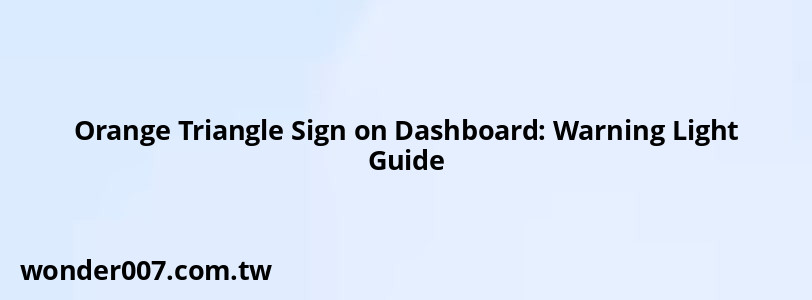Orange Triangle Sign on Dashboard: Warning Light Guide

Understanding the Orange Triangle Warning Light
The orange triangle with an exclamation point on your car's dashboard is a general warning light. It typically indicates that there's an issue with your vehicle that requires attention, but it's not immediately critical. This light is also known as the master warning light or vehicle stability assist (VSA) system warning.
When this light illuminates, it's usually accompanied by other warning lights or messages on your vehicle's information display. The specific meaning can vary depending on your car's make and model, but some common causes include:
- Low tire pressure
- Faulty anti-lock braking system (ABS)
- Issues with the vehicle stability control system
- Problems with the traction control system
- Malfunctioning sensors
What to Do When You See the Orange Triangle
If you notice the orange triangle warning light on your dashboard, follow these steps:
1. Don't panic. The orange color indicates that the issue isn't immediately critical.
2. Check your vehicle's information display for any accompanying messages.
3. Safely pull over if you're able to do so.
4. Consult your vehicle's owner manual for specific guidance.
5. If the light persists, schedule an appointment with a qualified mechanic.
Potential Causes and Solutions
Tire Pressure Issues
One common cause of the orange triangle warning is low tire pressure. Check your tire pressure and inflate them to the recommended levels if necessary.
Vehicle Stability Assist (VSA) System
If the light is related to the VSA system, it could indicate a problem with your vehicle's stability control. This system helps maintain traction and prevent skidding.
Anti-Lock Braking System (ABS)
An issue with the ABS could trigger the orange triangle warning. The ABS prevents wheel lock-up during hard braking.
Importance of Addressing Warning Lights
It's crucial to address dashboard warning lights promptly. Ignoring them can lead to:
- Reduced vehicle performance
- Decreased fuel efficiency
- Potential safety hazards
- More expensive repairs if issues are left unattended
Prevention and Maintenance
To minimize the chances of seeing the orange triangle warning light:
- Follow your vehicle's recommended maintenance schedule
- Regularly check tire pressure and other fluid levels
- Address any unusual noises or performance issues promptly
- Keep your vehicle's software up to date if applicable
Remember, while the orange triangle isn't as urgent as a red warning light, it still indicates a problem that needs attention. Always prioritize your safety and the longevity of your vehicle by addressing warning lights in a timely manner.
FAQs About Orange Triangle Warning Lights
- Can I continue driving with the orange triangle light on?
While not immediately critical, it's best to have your vehicle checked as soon as possible to prevent potential issues. - Will the light turn off on its own?
In some cases, it may turn off if the issue resolves itself (e.g., tire pressure returns to normal). However, it's still advisable to have your vehicle inspected. - How urgent is the orange triangle compared to other warning lights?
Orange or yellow lights generally indicate issues that need attention soon but aren't immediately critical. Red warning lights typically require immediate action.
Related Posts
-
Dodge RAM 1500: Understanding Warning Lights and Symbols
26-01-2025 • 173 views -
Chevy Trailblazer: Understanding Dashboard Warning Lights
26-01-2025 • 193 views -
How To Reset Adblue Warning Light
31-01-2025 • 191 views -
U Joint Replacement: A Guide to DIY Without Drive Shaft Removal
30-01-2025 • 163 views -
Chevy Silverado Tow/Haul Mode Fuse Location Guide
28-01-2025 • 162 views
Latest Posts
-
Are O2 Sensors Covered Under Warranty
01-02-2025 • 376 views -
2015 Chevy Traverse AC Recharge Port Location
01-02-2025 • 409 views -
Rear Brake Caliper Piston Won't Compress
01-02-2025 • 356 views -
Power Steering Fluid Leak On Passenger Side
01-02-2025 • 457 views -
How To Turn Off Paddle Shifters Mercedes
01-02-2025 • 377 views
Popular Posts
-
Hino Warning Lights: Understanding Dashboard Alerts
26-01-2025 • 765 views -
EPC Light: Understanding Causes and Solutions
26-01-2025 • 1053 views -
EPC Warning Light: What It Means for Your Vehicle
27-01-2025 • 630 views -
Power Steering and ABS Light On: Causes and Solutions
27-01-2025 • 643 views -
V12 Engine Costs: What You Need to Know
26-01-2025 • 679 views
